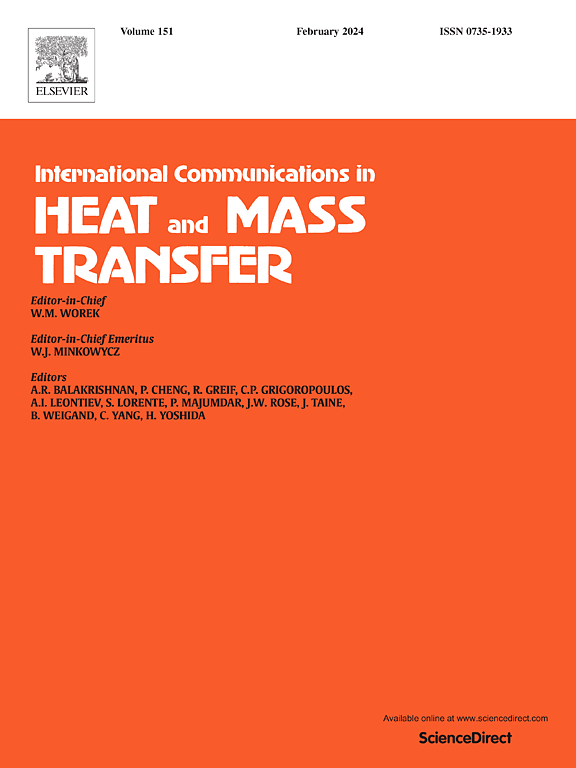Advanced bifurcated fin design with diversion channels for optimizing output performance of thermoelectric generators
IF 6.4
2区 工程技术
Q1 MECHANICS
International Communications in Heat and Mass Transfer
Pub Date : 2025-05-10
DOI:10.1016/j.icheatmasstransfer.2025.109078
引用次数: 0
Abstract
A new bifurcated fin structure, composed of one main fin and two two-stage fins, is introduced to enhance temperature uniformity in the heat exchanger and improve the performance of automotive thermoelectric generators (ATEGs). Besides, diversion channels are integrated into the fins to guide exhaust flow, ensuring full contact between the exhaust air and the fin surface. The advantages of bifurcated fins are validated through a multiphysics field numerical model, and the effect of four different diversion channels on ATEG's performance is explored. The results indicate that bifurcated fins significantly enhance the temperature and temperature uniformity of the heat exchanger, leading to a 20.09 % increase in output power and a 3.01 % increase in voltage uniformity of the ATEG. Diversion channels with simple shapes significantly reduce the exhaust pressure drop, whereas those with complex shapes cause a substantial increase. The optimal diversion channel for the plate fin is the reticulated diversion channel, whereas the straight diversion channel is best suited for the bifurcated fin. Furthermore, the diversion channel provides a greater performance improvement for the plate fin than for the bifurcated fin. This work offers a strong theoretical and practical foundation for designing innovative fins that enhance the performance of ATEGs.
优化热电发电机输出性能的带导流通道的先进分叉翅片设计
提出了一种由一个主翅片和两个二级翅片组成的新型分岔翅片结构,以提高换热器内的温度均匀性,提高汽车热电发电机的性能。此外,导流通道集成在翅片中,引导排气流动,确保排气与翅片表面充分接触。通过多物理场数值模型验证了分叉鳍的优势,并探讨了四种不同导流通道对ATEG性能的影响。结果表明,分叉翅片显著提高了换热器的温度和温度均匀性,使ATEG输出功率提高20.09%,电压均匀性提高3.01%。形状简单的导流通道能显著降低排气压降,而形状复杂的导流通道则能显著提高排气压降。板鳍的最佳导流通道是网状导流通道,而直导流通道最适合分叉鳍,并且板鳍的导流通道比分叉鳍的导流通道有更大的性能提升,本研究为设计提高ags性能的创新鳍提供了强有力的理论和实践基础。
本文章由计算机程序翻译,如有差异,请以英文原文为准。
求助全文
约1分钟内获得全文
求助全文
来源期刊
CiteScore
11.00
自引率
10.00%
发文量
648
审稿时长
32 days
期刊介绍:
International Communications in Heat and Mass Transfer serves as a world forum for the rapid dissemination of new ideas, new measurement techniques, preliminary findings of ongoing investigations, discussions, and criticisms in the field of heat and mass transfer. Two types of manuscript will be considered for publication: communications (short reports of new work or discussions of work which has already been published) and summaries (abstracts of reports, theses or manuscripts which are too long for publication in full). Together with its companion publication, International Journal of Heat and Mass Transfer, with which it shares the same Board of Editors, this journal is read by research workers and engineers throughout the world.

 求助内容:
求助内容: 应助结果提醒方式:
应助结果提醒方式:


